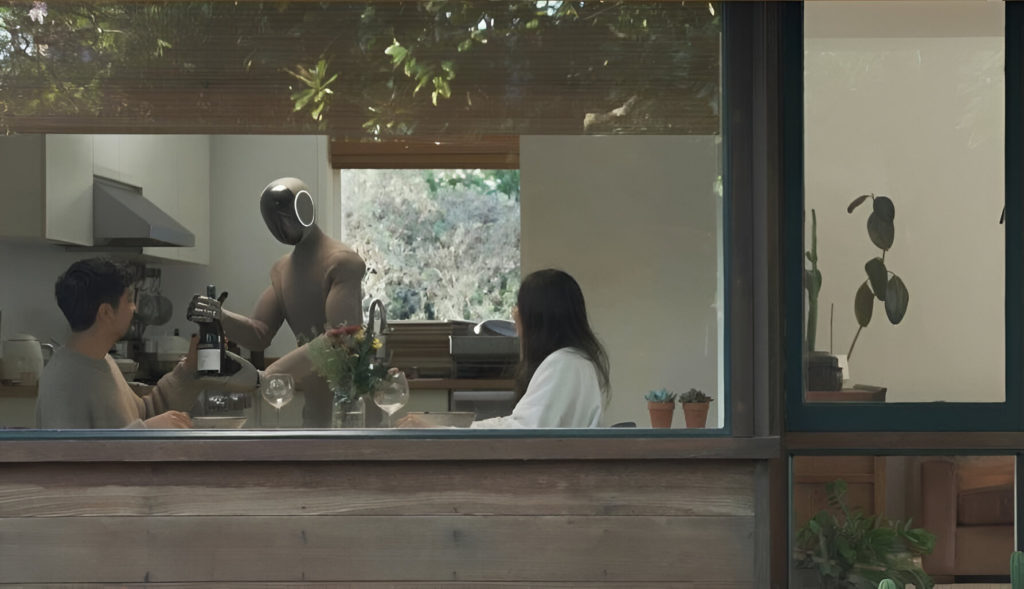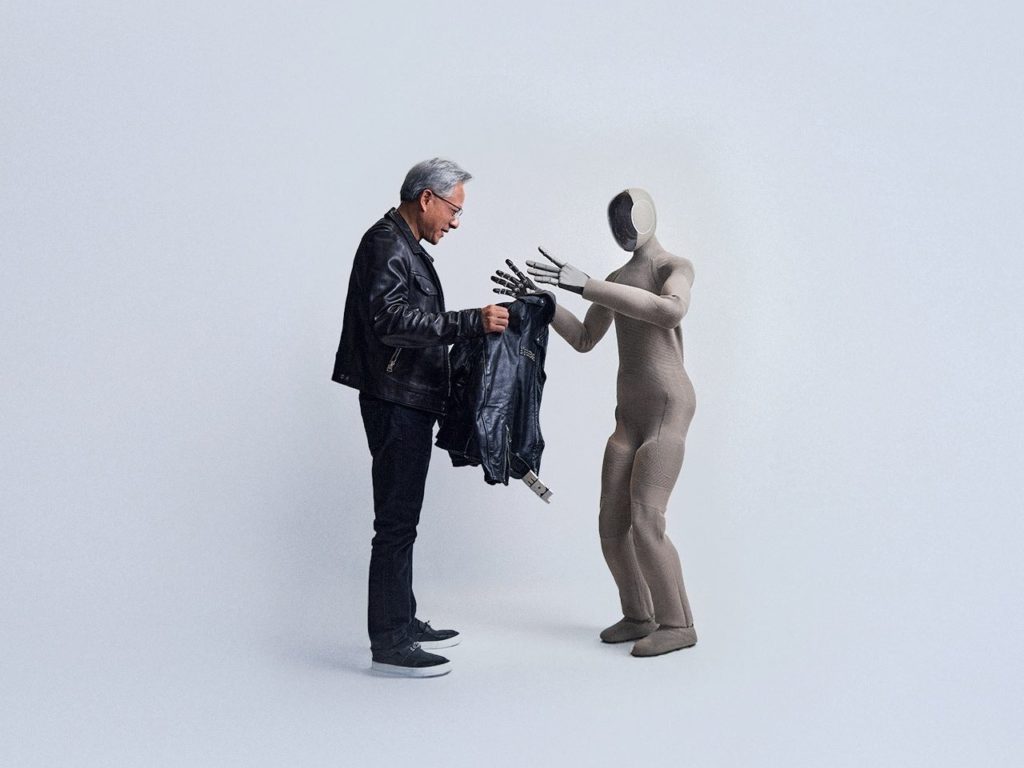This article explores how its innovative “soft robotics” approach transforms both the appearance and functionality of home assistants, creating machines that feel like natural additions to living spaces rather than intrusive technology. The NEO Gamma from 1X Technology represents a revolutionary approach to humanoid robot design that prioritizes domestic integration over industrial efficiency. By addressing the psychological barriers that have kept robots from becoming household fixtures, the NEO Gamma may signal a turning point in our relationship with domestic automation.
1. The “Too Robotic” Problem

For decades, humanoid robots have remained stuck in an uncanny valley – too mechanical to feel natural in our living spaces. Traditional designs feature rigid plastic shells, exposed mechanical joints, and industrial aesthetics that create an immediate sense of otherness. These machines may function efficiently, but their appearance creates psychological distance, making them feel like intruders rather than helpers in our homes. This fundamental design problem has persisted even as robotic technology has advanced, creating a significant barrier to adoption. The NEO Gamma addresses this core issue by acknowledging that for robots to succeed in domestic environments, they must adapt to human aesthetic preferences rather than forcing humans to accept industrial design in their personal spaces.
2. The Textile Revolution: Fabric-Like “Skin”

The NEO Gamma’s most striking innovation is its 3D-printed nylon fabric “skin” that transforms both its appearance and our psychological response to it. Unlike traditional hard plastic shells, this soft, textile-like exterior creates an immediate visual softening that helps the robot blend seamlessly into domestic environments. The fabric covering conceals complex machinery underneath while creating a more approachable presence. This design choice demonstrates 1X Technology’s understanding that robotic acceptance isn’t just about functionality but about emotional response. The fabric exterior makes NEO feel more like furniture or clothing – familiar elements we’re comfortable having in our personal spaces – rather than industrial equipment that feels out of place among soft furnishings and organic shapes.
3. Silent Operation Through Flexible Design

Beyond aesthetics, NEO’s knit suit serves important practical functions. The flexible nylon material accommodates the robot’s full range of motion without restricting movement or creating the unsettling mechanical sounds typically associated with robots. Traditional humanoids often produce clicking, whirring, and hydraulic noises that constantly remind us of their mechanical nature. NEO’s quieter operation proves crucial for a device designed to share living spaces with humans, where harsh mechanical sounds would quickly become irritating or disruptive to the peaceful atmosphere most people desire in their homes. This silent functionality allows the robot to perform tasks without constantly drawing attention to itself – a subtle but important feature for something that may be working in the background of daily life.
4. Biomimetic Hand Design

NEO’s hands demonstrate 1X’s understanding that effective domestic assistance requires dexterity rather than brute strength. The tendon-driven motion system mimics human biomechanics, allowing for gentle yet precise interactions with household objects. Industrial robots typically use rigid grippers designed for repetitive tasks in controlled environments. In contrast, homes are filled with irregularly shaped, delicate, and varied items that require adaptive handling. NEO’s sophisticated hand design enables it to manage everything from organizing scattered toys to loading dishwashers without damaging delicate items – tasks that previous generations of robots simply couldn’t accomplish safely. This capability transforms the robot from a novelty into a genuinely useful household assistant.
5. Custom Footwear for Stability

The attention to detail in NEO’s design extends to its custom 3D-printed shoes that complete the humanoid silhouette while providing stable footing across various household surfaces. This seemingly minor element serves both practical and aesthetic purposes. Functionally, specialized footwear helps the robot navigate different flooring materials found in homes – from hardwood and tile to carpet and rugs – without slipping or damaging surfaces. Aesthetically, the shoes contribute to NEO’s overall humanoid form in a way that feels familiar rather than alien. This holistic approach to design demonstrates 1X Technology’s understanding that every element of a domestic robot must be considered not just for technical function but for how it contributes to user acceptance.
6. Illuminated Communication Interface

Perhaps the most intriguing design element is NEO’s illuminated ear rings, which serve as a communication interface rather than mere decoration. These light loops provide visual feedback about the robot’s status, intentions, and responses – creating an intuitive way for humans to understand what NEO is doing without requiring constant attention to a separate control screen or app. Traditional robots often require users to check displays or smartphones to understand what they’re doing or planning next. NEO’s ambient communication method feels natural and unobtrusive, allowing for smoother human-robot coexistence. The light patterns can indicate when the robot is listening, processing information, or completing tasks – similar to how humans use facial expressions and body language to communicate without words.
7. Focus on Genuine Household Needs

The NEO Gamma addresses genuine household needs rather than focusing on novelty features that quickly lose their appeal. By handling tidying, deep cleaning, and organizational tasks that consume significant time in most households, the robot potentially frees family members to focus on meaningful interactions and activities. This practical approach recognizes that the true value of domestic robots isn’t in their technological impressiveness but in how they improve quality of life. By automating routine chores, NEO allows humans to dedicate more time to the emotional and creative aspects of experience that machines cannot replicate – the connections and pursuits that make life meaningful.
8. Minimalist Aesthetic Integration

Unlike industrial robots designed solely for efficiency, NEO acknowledges that acceptance in domestic spaces requires thoughtful consideration of how the robot’s presence affects the overall atmosphere of a home. Its minimalist aesthetic extends to every aspect of its design, allowing it to complement rather than disrupt home environments. This approach represents a significant shift in thinking about robotics design – from machines that demand attention to assistants that blend into the background when not actively engaged. The neutral, understated appearance allows NEO to exist in various design contexts without becoming a jarring technological intrusion in carefully curated living spaces.
9. Psychological Acceptance Through Design

The NEO Gamma’s design directly addresses the psychological barriers that have kept robots from becoming household fixtures. By softening the machine’s appearance and behavior, 1X Technology has created a robot that feels less threatening and more approachable. This psychological consideration may prove as important as technical capabilities in determining whether robots successfully integrate into domestic life. Research consistently shows that humans respond negatively to machines that appear too mechanical when placed in intimate settings like homes. By addressing this emotional response through thoughtful design, NEO potentially overcomes the discomfort that has limited adoption of previous humanoid robots.
10. A New Design Philosophy for Domestic Robotics

The NEO Gamma represents more than just a single product – it embodies a fundamental shift in how we think about designing robots for human spaces. Rather than emphasizing technological capabilities through visible mechanisms and industrial aesthetics, this new approach prioritizes human comfort and psychological acceptance. By adapting robots to fit gracefully into existing environments rather than forcing environments to accommodate robots, 1X Technology establishes a design philosophy that could guide the next generation of domestic automation. This human-centered approach recognizes that successful integration of robots into daily life isn’t just about what machines can do, but how comfortably we can live alongside them.




























